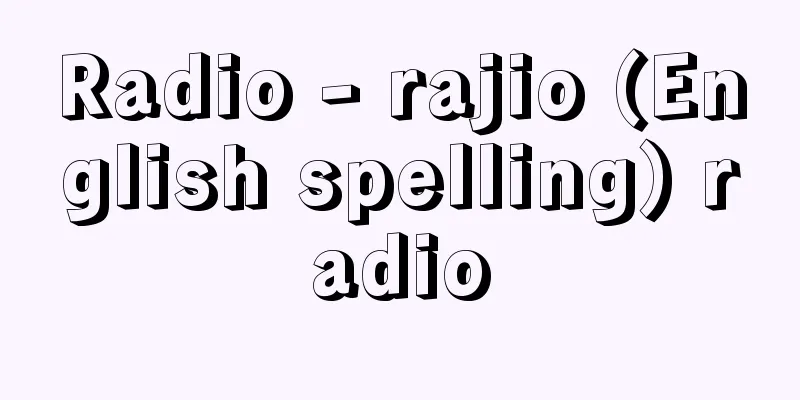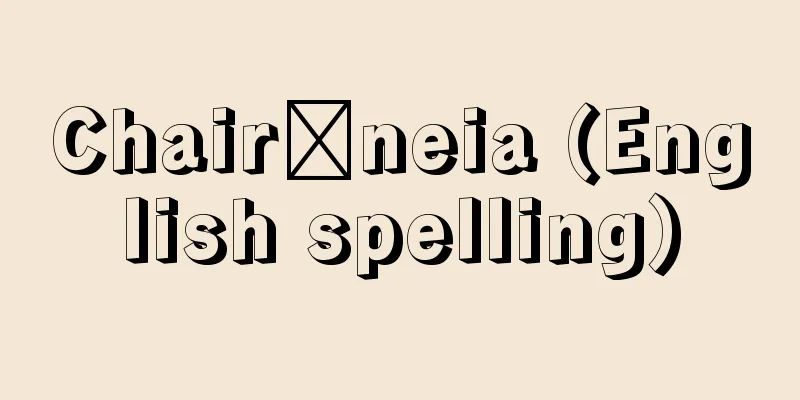Radio - rajio (English spelling) radio

|
Although it is a term that broadly refers to radio in general, it generally refers to radio-wave audio broadcasting and its receivers. Radio broadcasting uses medium wave, short wave, and VHF radio waves, each of which has its own characteristics and features. In Japan, medium wave is used as the standard domestic broadcasting, short wave is mainly used for international broadcasting overseas, and VHF is used for FM broadcasting, which has superior sound quality. [Kimura Satoshi] historyIn 1888, H. R. Hertz demonstrated the existence of electromagnetic waves (radio waves), and in 1895, Marconi succeeded in the first wireless telegraph experiment, opening up the possibility of radio wave communication. In 1900, American R. A. Fessenden invented a high-frequency generator-type wireless telephone, and on Christmas Eve 1906, an experimental station in Brant Rock, Massachusetts used this wireless telephone (long wave) to transmit music and greetings over the air. According to "Fifty Years of Broadcasting" (edited by the Japan Broadcasting Corporation), this was probably the first radio broadcast. Also in 1906, American John de Forest invented the triode vacuum tube, paving the way for the development of devices for generating and modulating continuous radio waves, which are essential for radio broadcasting. In 1908, de Forest traveled to France, where he attracted attention by broadcasting recorded music from the Eiffel Tower, and in 1910 he broadcast a live opera from the Metropolitan Opera in New York. In 1920, the American company Westinghouse opened KDKA in Pittsburgh, which became the world's first fixed radio station. KDKA's broadcast of the presidential election results drew a huge response, and the number of radio stations in America subsequently increased rapidly. By the end of 1922, two years later, there were 569 radio stations across the US. In Europe, the United Kingdom, the Netherlands, and Germany began experimental broadcasting in 1920, followed by France in 1921. From 1922, French national broadcasting, the British Broadcasting Company (the forerunner of today's BBC), and the Soviet Moscow Radio (which became the Voice of Russia after the collapse of the Soviet Union) began regular broadcasting. In Japan, radio waves were first transmitted by a private citizen in 1921 (Taisho 10). In 1923, the Ministry of Communications enacted a ministerial ordinance entitled "Regulations for Private Wireless Telephones for Broadcasting Use," and public radio experiments were held all over the country by newspaper companies and others, which led to growing public interest in radio. On March 22, 1925, the Tokyo Broadcasting Association began provisional broadcasting at 220 watts from the Tokyo Higher Technical School in Shibaura. Full-scale broadcasting began in July of the same year at 1 kilowatt from a newly renovated station building at Atagoyama in Shiba, Tokyo. The Osaka Broadcasting Station and Nagoya Broadcasting Station also opened in the same year, and the following year, in 1926, these three stations were consolidated into the Japan Broadcasting Corporation (now a special corporation). In 1950, the Radio Law, Broadcast Law, and Law for Establishment of the Radio Regulatory Commission were enacted, opening up broadcasting, which had previously only been conducted by the Japan Broadcasting Corporation (NHK), to the general public and making it possible to establish private broadcasters run by advertising revenues. In September of the following year, 1951, Chubu Nippon Broadcasting in Nagoya and New Japan Broadcasting in Osaka (now Mainichi Broadcasting System) opened, and private broadcasting stations followed one after another in other areas. Since shortwave broadcasting can reach long distances, it has been used in Japan since 1935 for overseas broadcasting. Initially, it was a one-hour broadcast in Japanese and English to North America and Hawaii, but as of 2012, a total of 55 hours and 55 minutes of broadcasts are being made in 18 languages to the whole world from the Yamata transmitting station (Ibaraki Prefecture) in Japan and 11 overseas relay transmitting stations (21 if AM and FM broadcasts are included). Meanwhile, since 1954, the private broadcasting company Japan Shortwave Broadcasting (which changed its name to Nikkei Radio in 2003) has been providing news, stock information, and other services to the whole of Japan from two transmitting stations in Nagara, Chiba and Nemuro, Hokkaido. The foundations of VHF FM broadcasting were laid with the invention of frequency modulation (FM) by American E. H. Armstrong in 1929 and the successful practical application of the method in 1936. The world's first experimental FM broadcasting station was established in the United States in 1938, and stereo broadcasting began in 1961. After World War II, West Germany's medium wave frequency allocation was reduced, so the country planned to cover the entire country through FM broadcasting, which began in 1949. In Japan, the first experimental station was opened in NHK Tokyo in December 1957, and the following year in 1958, FM Central was also allowed to open an experimental station. After that, studies were conducted on the signal multiplexing method for stereo broadcasting, and in December 1963, nine existing stations, including NHK Tokyo, Osaka, and Nagoya, began experimental stereo broadcasting (monophonic broadcasting was a practical test). FM broadcasting in Japan had a long period of practical test or experimental broadcasting, and it was not until March 1969 that regular broadcasting finally began. By this time, NHK had already set up 170 FM broadcasting stations nationwide, and all of these were converted to regular broadcasting at once. Commercial FM stations were then established in Tokyo, Osaka, Nagoya, and Fukuoka. Meanwhile, discussions began in 1975 regarding signals that could be superimposed on FM broadcasting radio waves, and in 1994 the private FM Tokyo station began FM text broadcasting (service name: "Visible Radio"), which transmits text information along with audio. Other stations subsequently joined in, broadcasting information related to the audio, such as station names, as well as information independent of the audio, such as news. However, the demand for text broadcasting has decreased due to a decline in radio listeners and the spread of the Internet. The Visible Radio service ended in March 2014. [Kimura Satoshi] Radio broadcasting waves and their propertiesMedium wave broadcastingIt is a medium-wave broadcasting band that uses radio waves from 526.5 to 1606.5 kHz, and in Japan it is allocated to use frequencies from 531 to 1602 kHz in 9 kHz intervals. The broadcasting method used is double-sideband amplitude modulation, which simultaneously transmits the carrier component and the upper and lower sidebands generated by amplitude modulating (AM) the carrier with an audio signal. Because of its long wavelength, medium wave broadcasting mainly propagates along the earth's surface and is less affected by terrain, so each station can have a wide service area; it is not affected by obstruction or reflection by buildings, so reception is stable even in moving objects such as automobiles; and receivers are relatively simple, reliable, and inexpensive to make. On the other hand, there are several problems with medium wave broadcasting, such as the audio bandwidth being limited to 7.5 kHz, which means that the sound quality is inferior to that of FM broadcasting at 15 kHz; the frequency used is low, so there is a lot of interference from natural noise such as atmospherics and artificial noise, which is difficult to improve; and at night, the ionosphere occurs, which reflects medium wave waves, causing interference from distant broadcasting stations. With the development of FM broadcasting, issues of improving the sound quality of medium wave broadcasting and stereo broadcasting came to the forefront, leading to the implementation of high-frequency emphasis and stereo broadcasting in the United States. Following the practical application of high-frequency emphasis, Japan also adopted the C-QUAM (compatible quadrature amplitude modulation system), the same method as in the United States, as the standard method for stereo broadcasting, and in 1992 (Heisei 4), five commercial broadcasting stations in Tokyo and Osaka began using it. As of 2000, 16 commercial broadcasting stations were using it, but in the second half of the 2000s, many stations switched to mono broadcasting, and stereo broadcasting was only implemented by a few stations. [Kimura Satoshi] Shortwave BroadcastingShortwave radio waves are reflected by the ionosphere (E and F layers) and can reach distances of several thousand kilometers, so they are mainly used for international broadcasting, as well as domestic broadcasting in countries with large land areas that do not have a complete broadcasting network. The frequencies used are 3, 6, 7, 9, 11, 15, 17, 21, and 25 MHz. The height and density of the ionosphere change depending on the season and the time of day, influenced by the sun. Therefore, in order to efficiently deliver radio waves to the receiving area, broadcast times and frequencies are selected, and even for broadcasts to the same area, frequencies are switched depending on the time of day, or multiple radio waves are used. It goes without saying that frequencies are changed depending on the season. The modulation method is the same as that of medium wave broadcasting, double-sideband amplitude modulation, and the frequency interval is 5 kHz. Currently, there are many stations on one frequency for shortwave broadcasting. In order to get better reception, the power of each station is increased, which leads to a vicious cycle of increasing interference. Therefore, in order to make more efficient use of frequencies, the introduction of a single sideband broadcasting system, which transmits only either the upper or lower sideband, is now being considered internationally. Japan's overseas broadcasting service, Radio Japan, produces programs for which NHK broadcasts using KDDI's transmission facilities, and also broadcasts via rented broadcasting facilities in Canada, Gabon, etc. Nikkei Radio, which broadcasts domestically on shortwave, broadcasts using relatively low-frequency radio waves in the 3, 6, and 9 MHz bands in an attempt to cover Japan, which has a long and narrow land area stretching from the northeast to the southwest, with a single station. Shortwave broadcasting uses radio waves reflected from the complex ionosphere, so several radio waves arrive at the receiving point along different propagation paths. These waves interfere with each other, causing changes in the volume and sound quality of the broadcast. This phenomenon is called fading. Fading is not limited to shortwave, but it is most noticeable on shortwave. [Kimura Satoshi] Very short wave broadcastingIt is an audio broadcasting using radio waves in the VHF band, and is generally called FM broadcasting because the modulation method is frequency modulation (FM). The frequencies allocated to FM broadcasting in Japan are from 76 to 90 MHz, and the frequency width of each station is 0.2 MHz. FM broadcasting is characterized by its resistance to external noise, its large dynamic range (the difference in the volume of sound), and its wide transmission frequency band, allowing for high-fidelity and stereo broadcasting with good sound quality. However, VHF radio waves have a strong tendency to travel in a straight line, so the service area is limited, and many broadcasting stations are required for nationwide broadcasting. Radio waves are also reflected by mountains and buildings, so if care is not taken to use a directional antenna to receive only direct waves, sound distortion will occur. All FM broadcasting stations currently operating in Japan are broadcasting in stereo. The system used is the "carrier suppressed AM-FM system" (pilot tone system) that takes into consideration compatibility with monophonic broadcasting. This system transmits the sum of the left and right sounds as a monophonic signal on the main channel, and the difference between the left and right sounds as a signal for stereo reproduction on the sub-channel. The sub-channel multiplexes a 38 kHz subcarrier into the main channel by amplitude modulating (AM), and instead of suppressing the subcarrier, it adds a 19 kHz pilot signal. Finally, the main carrier is frequency modulated (FM) by these multiplexed signals. Meanwhile, for FM multiplex broadcasting, which can superimpose other signals onto FM broadcasting radio waves, studies on a fixed reception method began in 1975, but development of a method of broadcasting with added data such as road traffic information for mobile devices also progressed. Finally, the DARC (data radio channel) method, which can transmit text, graphics, additional information, road traffic information, and other data at a high transmission capacity, was recommended by the ITU-R (International Telecommunication Union Radiocommunication Sector) in 1995. In Japan, FM text multiplex broadcasting began in 1994, providing song titles, artist names, news, weather, and other information related to the program (ended in March 2014). In addition, in 1996, the VICS (Vehicle Information and Communication System) service was launched to provide traffic information for mobile devices. [Kimura Satoshi] Broadcasting Station EquipmentThe facilities of a radio station can be broadly divided into program production equipment such as studios and microphones, the operational equipment necessary for broadcasting the programs, and transmission equipment for transmitting the programs over radio waves. [Kimura Satoshi] MicrophoneA device that converts sound, i.e. air vibrations, into an electrical signal. Currently, the main types of transducers in use are those that extract the voltage generated by the vibration of a coil or thin aluminum film placed in a magnetic field, and those that extract the change in electrostatic capacitance between a diaphragm and a fixed electrode placed close to it. They come in a variety of shapes and functions, and are used according to the application. [Kimura Satoshi] Radio StudioRadio stations are equipped with several studios, each with different sizes and acoustic characteristics depending on the purpose, such as music, drama, disc jockey, etc. The inside of the studio needs to be completely isolated from outside noise and vibration, so the walls are made of double-layered concrete and the studio itself is made of a floating structure that isolates it from the main building with anti-vibration rubber. In addition, careful attention is paid to the soundproof doors at the studio entrance and the sound of air flow through the ventilation ducts. The characteristics that affect the acoustics of a studio are reverberation and reflection. If the reverberation time is long, the separation of sounds becomes unclear, and if it is too short, the sound loses richness. The optimal reverberation time is about 0.25 seconds for a speech studio where the clarity of words is an issue, 0.35 to 0.6 seconds for a general studio for dramas, small-scale music, and choruses, and 1 second or more for a music studio where the sound and balance of each instrument are required. Reverberation is also affected by the shape of the room. Depending on the ratio of the dimensions of the three sides of the room, the reverberation of certain frequencies will linger for a long time. To prevent this, it is said that it is best to set the ratio of the studio's width, depth, and height to ( 3 ) n . In addition, various sound-absorbing materials are used on the walls of the studio to obtain the optimal reverberation time. To prevent the cry dragon phenomenon and echoes caused by reflection, it is best to avoid having the floor, ceiling, and opposing walls parallel to each other. In music programs, a microphone is set up for each instrument, and the sound effects are enhanced by mixing. For this reason, studios with multiple soundproofing booths have been introduced to eliminate overlapping sounds from other instruments. The equipment in the studio includes a clock, a microphone outlet, a talkback system to convey instructions from the sub-control room, etc. The announcer's microphone has a volume control that can be operated by hand. [Kimura Satoshi] Sub-control roomThis is a room where the volume of several to a dozen microphones installed in the studio is adjusted appropriately, and where music and sound effects tapes and records are played and mixed with the studio sound or switched to create a program. It is located next to the studio. Therefore, the sub-control room is equipped with an audio control desk, monitor speakers, tape recorders, record players, CD players, MD players, DAT (digital audio tape recorders), etc. The functions of the control desk vary depending on the size of the studio, but it can not only switch and mix sounds, but also change the tone and add reverberation, which helps to improve the effect of the program. Recording with multi-track recorders has become popular for music programs, and control rooms have been installed to create broadcast programs from these tapes. In addition, production methods using DAWs (digital audio workstations) are becoming mainstream. DAWs are desktop tapeless audio recording systems that perform editing, synchronization, playback, mixing, and other processes while keeping the signals digital. DAWs have excellent features such as displaying the waveform of audio signals on the screen and high-speed random access, making it possible to carry out tasks with greater precision and efficiency in areas such as audio post-processing and editing (known as post-production or MA work). Today's DAWs are divided into systems that use dedicated software on a personal computer and systems that use dedicated hardware. Operation is performed with a keyboard, mouse, touch screen, tablet pen, etc. Recording media include RAM, large-capacity hard disks, and optical magnetic disks. In the future, we can expect to see new developments beyond standalone devices such as DAWs, such as all-digital audio broadcasting systems (DTRs, desktop radios) that connect digital audio equipment within a broadcasting station via a network and handle everything from receiving to transmitting audio signals over the network. [Kimura Satoshi] Master Control RoomThe outputs of each sub-control room, broadcasting sites, and programs from other broadcasting stations are collected here, switched according to time, and sent to broadcasting stations and other broadcasting stations. In medium wave radio, which has a lot of live broadcasts, the sound from the studio passes through the sub-control room and master control room and is sent directly to the broadcasting station, but many educational programs and commercials on FM and medium wave radio are recorded programs, and a recording and playback device is installed in the master control room for broadcasting. A computer system is used to switch programs in the master control room, which handles complex tasks efficiently. [Kimura Satoshi] External productionCompared to television, the outdoor production of audio programs is simpler and easier, and there is a lot of mobility. Therefore, a wide range of programs are produced, from news, sports, and theater to recording natural sounds. One thing to be careful of when producing outdoors is the sound of wind entering the microphone. Care must be taken when selecting a microphone, and wind noise must be reduced by using a windscreen, etc. If the sound source is moving, a wireless microphone should be used, and if the source cannot be approached, a sound collector should be used. Audio signals for external broadcasts are usually sent to the master control room via telephone lines, but with an increase in broadcasts from mobile vehicles such as broadcast vans, news cars, and helicopters, VHF telephone contact devices are being used. [Kimura Satoshi] Broadcasting StationBroadcasting stations, which transmit audio programs over radio waves and send them into space, are equipped with broadcasting equipment, antennas, emergency power supply equipment, etc. Medium wave and short wave broadcasting stations require a large site, and because the strong radio waves make it impossible to receive radio waves from other stations near the broadcasting station, they are built in the suburbs where there are few houses. Similarly, VHF broadcasting stations are placed on tall steel towers within the city or on mountaintops near cities, just like television broadcasting stations, and programs from studios are delivered to the broadcasting stations via wired or wireless links. As broadcasting equipment has become more stable and reliable, broadcasting stations are becoming unmanned and are controlled remotely from a master control room. Medium wave broadcasting is an important broadcasting medium in times of emergency disasters. This was recognized during the Great Hanshin-Awaji Earthquake in 1995. Therefore, medium wave broadcasting equipment must be highly reliable, and in addition to adopting a system in which two or more transmitters of the same specification are operated in parallel, many also have spare transmitters. In addition, private power generation facilities are also installed. Medium wave broadcasting transmission antennas often use half-wavelength vertical antennas with guyed cylindrical iron poles, which have high gain and good anti-fading effects. Since the wavelength of medium wave is several hundred meters, the antenna height is around 200 meters. A large site is inevitably required to stretch the antenna guy wires and the radial copper wire (earth) buried underground. The transmission antenna heights of the NHK Tokyo Broadcasting Station's Shobu-Kuki Broadcasting Station (First Broadcasting 300 kilowatts, 594 kilohertz, Second Broadcasting 500 kilowatts, 693 kilohertz) are 245 meters and 215 meters, respectively. Shortwave broadcast transmitters may change their transmission frequency several times throughout the day because they need to select the optimal frequency depending on the direction of transmission and the time of transmission. Also, to efficiently transmit radio waves in the required direction, directional antennas are connected and used. Therefore, it is desirable to be able to easily switch frequencies and change antenna connections. VHF broadcasting is subject to the same conditions as television transmission, and is often installed alongside television broadcasting stations and shares the same transmission tower. Also, like television, relay stations that receive and retransmit radio waves from the master station are set up in mountainous areas and on remote islands. [Kimura Satoshi] Future OutlookBS digital broadcasting, which started in December 2000, mainly provides high-definition broadcasting and data broadcasting, but also offers BS digital audio broadcasting (BS digital radio) in addition to television broadcasting. BS digital radio ended broadcasting in 2007, but resumed in 2011 when The Open University of Japan began broadcasting. Meanwhile, in the field of terrestrial digital broadcasting, ahead of the launch of television (terrestrial digital television broadcasting) in December 2003, test broadcasts of terrestrial digital audio broadcasting (digital radio) began in the Tokyo and Kinki regions in October of the same year, but broadcasting ended at the end of March 2011. [Kimura Satoshi] "Fifty Years of Broadcasting," edited by the Japan Broadcasting Corporation (1977, Japan Broadcast Publishing Association)" ▽ "Broadcasting Technology Series," edited by the Japan Broadcasting Corporation, all 14 volumes (1982, Japan Broadcast Publishing Association)" ▽ "Digital Broadcasting Technology Encyclopedia," edited by the NHK Science and Technology Research Laboratories (1994, Maruzen)" ▽ "Broadcasting Handbook," edited by the Japan Commercial Broadcasters Association (1997, Toyo Keizai Inc.)" ▽ "Radio is Always a Hot Medium," by Yoshioka Sho (1997, Yumitachisha)" ▽ "The Age of Radio," by Takeyama Akiko (2002, Sekaishisosha)" ▽ "NHK Broadcasting Culture Research Institute, edited by NHK Databook of World Broadcasting," various annual editions (Japan Broadcast Publishing Association) [Reference items] | | | | | | | | | | | | | | | |A receiver using five vacuum tubes. It was a high-performance receiver for the time. ©Shogakukan "> 5-bulb Super 1951 model... ©Shogakukan "> Radio transmitter and receiver configuration Source: Shogakukan Encyclopedia Nipponica About Encyclopedia Nipponica Information | Legend |
|
広く無線全般を意味することばだが、一般的には電波による音声放送とその受信機をさすことが多い。ラジオ放送には中波、短波、超短波帯の電波が、それぞれの特性・特徴を生かして用いられている。日本では中波が国内向け標準放送として、短波がおもに海外向け国際放送として、そして超短波が音質の優れたFM放送として使われている。 [木村 敏] 歴史1888年H・R・ヘルツが電磁波(電波)の存在を実証し、1895年マルコーニが初の無線電信実験に成功して、電波による通信の可能性が開けた。1900年にアメリカのR・A・フェッセンデンが高周波発電機式無線電話を発明、1906年のクリスマス・イブにマサチューセッツ州ブラントロックの実験局からこの無線電話(長波)によって音楽と挨拶(あいさつ)を電波にのせた。これがおそらく最初のラジオ放送だろうと『放送五十年史』(日本放送協会編)は述べている。また、同1906年には、アメリカのド・フォレストが三極真空管を発明し、ラジオ放送に欠かせない連続電波の発生と変調装置発展の基礎を開いた。1908年、ド・フォレストはフランスに渡り、エッフェル塔からレコード音楽を放送して注目を浴び、また1910年にはニューヨーク・メトロポリタン歌劇場からオペラの中継放送を行っている。 1920年アメリカのウェスティングハウス社がピッツバーグにKDKA局を開局、これが世界最初の固定のラジオ放送局となった。KDKA局が大統領選挙戦の開票結果を中継して大きな反響をよんだことから、その後アメリカのラジオ放送局は急速に増加し、2年後の1922年末には全米で569局を数えるまでになっている。 ヨーロッパでは1920年にイギリス、オランダ、ドイツが、また1921年にフランスが実験放送を始め、1922年からは、フランス国営放送、イギリス放送会社(現在のBBCの前身)、ソ連のモスクワ放送局(ソ連崩壊後は「ロシアの声」となる)などが本放送を開始している。 日本では1921年(大正10)に民間人によって初めてラジオ電波が発射された。1923年には逓信(ていしん)省令「放送用私設無線電話規則」が制定され、また新聞社などによるラジオの公開実験が各地で開かれて、一般のラジオへの関心が高まってきた。1925年3月22日、社団法人東京放送局が芝浦の東京高等工芸学校から仮放送を220ワットで開始した。本放送は、同年7月から東京、芝の愛宕(あたご)山に新装なった局舎から1キロワットで始まっている。大阪放送局、名古屋放送局も同年相次いで開局、翌1926年この3局は社団法人日本放送協会(現在は特殊法人)に一本化された。 1950年(昭和25)電波法、放送法、電波監理委員会設置法が成立し、それまで社団法人日本放送協会(NHK)でのみ行ってきた放送が一般にも開放され、広告料収入によって経営される民間放送の設立が可能になった。翌1951年9月には名古屋の中部日本放送と大阪の新日本放送(現、毎日放送)が開局、以後各地に次々と民間放送が開局した。 短波放送はその電波が遠距離まで届くということから、日本では1935年以来海外向け放送に利用されてきた。当初は北アメリカ、ハワイ向けに日本語と英語による1時間の放送であったが、2012年度(平成24)時点では、日本の八俣(やまた)送信所(茨城県)および11か所(中波放送とFM放送を含めた場合は21か所)の海外中継送信所から、全世界に向けて18の言語により、1日当り延べ55時間55分の放送が行われている。一方、1954年から、民間放送の日本短波放送(2003年日経ラジオ社に社名変更)が、千葉・長柄(ながら)と北海道・根室(ねむろ)の2か所の送信所から、日本全国を対象に、ニュース、株式などのサービスを開始している。 超短波FM放送は、1929年アメリカのE・H・アームストロングの周波数変調(FM)方式の発明と1936年の実用化成功でその基礎が開かれた。1938年世界最初のFM実験放送局がアメリカに誕生、ステレオ放送も1961年に始まっている。 第二次世界大戦後、中波の周波数割当てを削減された西ドイツは、FM放送による全国カバーを計画し、1949年に放送を開始した。 日本では1957年12月NHK東京に初めての実験局が開設され、翌1958年にはFM東海にも実験局開設が認められた。その後ステレオ放送の信号多重方式について検討が進められ、1963年12月、NHK東京、大阪、名古屋など既設の9局がステレオ実験放送を開始した(モノホニック放送については実用化試験となる)。日本のFM放送は、実用化試験あるいは実験放送の期間が長く、1969年3月になってようやく本放送開始となった。このときすでに、NHKは全国に170のFM放送局を設置しており、これが一挙に本放送となったのである。続いて東京、大阪、名古屋、福岡に民放FM局が誕生した。 一方、FM放送の電波に重畳できる信号の検討についても1975年から審議され、1994年に民間のエフエム東京が、音声とともに文字情報を送るFM文字多重放送(サービス名「見えるラジオ」)の放送を開始。その後他局も加わり、局名など音声と関連した情報およびニュースなど、音声と独立した情報を放送した。しかし、ラジオ受聴者の減少とインターネットの普及によって文字多重放送の需要は減少。見えるラジオのサービスは、2014年3月に終了となった。 [木村 敏] ラジオ放送の電波とその性質中波放送526.5~1606.5キロヘルツまでの中波帯の電波を使用する放送で、日本では531~1602キロヘルツの周波数を9キロヘルツ間隔で使うように割り当てられている。放送の方式としては、搬送波成分と搬送波を音声信号で振幅変調(AM)することによって生じる上・下の側帯波を同時に伝送する両側波帯振幅変調方式がとられている。 中波放送は、その波長の長いことから、電波がおもに地表に沿って伝搬し、また地形などの影響を受けにくいので、1局当りのサービスエリアが広くとれること、建造物による遮蔽(しゃへい)や反射による影響がなく、自動車などの移動体でも安定した受信ができること、さらには受信機が比較的簡単で信頼度が高く、安価につくれることなどの利点がある。その反面、音声帯域幅が7.5キロヘルツに制限されており、FM放送の15キロヘルツに比べて音質的に見劣りがすること、使用周波数が低いので空電などの自然雑音や人工雑音の混入が多く、しかもその改善がむずかしいこと、夜間になると中波帯を反射する電離層が発生するため、遠方の放送局の電波が到来して混信するなど、いくつかの問題点がある。 FM放送の発展に伴い、中波放送の音質改善やステレオ放送の問題がクローズアップされ、アメリカでは高域強調やステレオ放送が実施された。日本でも高域強調の実用化に続き、ステレオ放送についてもアメリカと同じ方式であるC-QUAM方式(compatible quadrature amplitude modulation system)を日本の標準方式とし、1992年(平成4)、東京と大阪の民放5局で開始された。その後2000年時点では民放16局で実施されていたが、2000年代後半にはモノラル放送への切替えが相次ぎ、ステレオ放送を実施するのは一部の局のみとなった。 [木村 敏] 短波放送短波帯電波は電離層(E層、F層)で反射され、数千キロメートルの遠方まで届くことから、おもに国際放送に使われるほか、国土が広く放送網の完備していない国などで国内放送に使われている。使用周波数は3、6、7、9、11、15、17、21、25メガヘルツ帯。電離層の高さや密度は、太陽の影響を受けて、季節や1日の時間帯によっても変化する。そのため受信地域に電波が効率よく届くよう、放送時間、放送周波数を選択するほか、同一地区へ向けての放送も時間帯によって周波数を切り替えたり、複数の電波を利用したりする。季節によって周波数を変更するのはいうまでもない。変調方式は中波放送と同じ両側波帯振幅変調、周波数間隔は5キロヘルツである。現在、短波放送は一つの周波数に何局もがひしめく状態にある。互いに良好な受信を求めて大電力化が進められ、これがまた混信を増大するという悪循環をもたらしている。そこでいま、周波数の有効利用を図ろうと、上・下いずれかの側波帯のみを伝送する単側波帯放送方式の導入が国際的に検討されている。 日本の海外放送「ラジオ日本」は、NHKが番組を制作し、KDDIの送信設備を使って放送するほか、カナダやガボンなどの放送施設を借りて中継放送を行っている。短波の国内放送を実施している日経ラジオ社は、東北から南西にかけて細長い国土をもつ日本を1局でカバーしようと、比較的周波数の低い3、6、9メガヘルツ帯の電波を使って放送している。 短波放送は複雑な電離層からの反射電波を利用するので、受信点には伝搬経路の異なったいくつかの電波が到来する。これが互いに干渉しあい、放送の音の大きさや音質に変化を生じる。これがフェージングとよばれる現象である。フェージングは短波に限ったものではないが、短波においてもっとも顕著に現れる。 [木村 敏] 超短波放送VHF帯の電波を使用する音声放送で、その変調方式が周波数変調(FM)であることから、一般にFM放送とよばれている。日本のFM放送に割り当てられている周波数は、76~90メガヘルツまでで、1局の周波数幅は0.2メガヘルツである。FM放送には、外来雑音に強く、ダイナミックレンジ(音の大きさの変化差)が大きく、伝送周波数帯域が広くとれるので、よい音質のハイファイ放送、ステレオ放送ができるという特徴がある。しかし、VHFの電波は直進性が強いのでサービスエリアが広くとれず、全国放送のためには多くの放送所を必要とするとか、山やビルによって電波が反射されるので、指向性アンテナを用いて直接波だけを受信するなどの注意を払わないと、音にひずみが生じるなどの問題もある。 現在設置されている日本のFM放送局は、すべてステレオ放送を実施している。その方式は、モノホニック放送との両立性を考慮した「搬送波抑圧AM-FM方式」(パイロットトーン方式)である。これは、主チャンネルにモノホニック信号となる左の音と右の音の和を、副チャンネルにステレオ再生用の信号として左と右の音の差を伝送するもので、副チャンネルは38キロヘルツの副搬送波を振幅変調(AM)して主チャンネルに多重化し、また副搬送波を抑圧するかわりに19キロヘルツのパイロット信号を付加している。最後にこれらの多重信号により主搬送波を周波数変調(FM)している。 一方、FM放送の電波に別の信号を重畳できるFM多重放送については、1975年(昭和50)から固定受信方式の検討が始められたが、移動体向けに道路交通情報などのデータを付加して放送する方式の開発も進められた。最終的に、文字、図形、付加情報、道路交通情報などの高い伝送容量を伝送可能なDARC(data radio channel)方式が、1995年(平成7)にITU-R(国際電気通信連合無線通信部門)で勧告された。日本では、1994年にFM文字多重放送が開始され、番組に関連する曲名やアーティスト名、ニュース、天気などが提供された(2014年3月終了)。また、1996年には移動体向けに交通情報を提供するVICS(ビックス)(道路交通情報通信システム)のサービスが開始された。 [木村 敏] 放送局の設備ラジオ放送局の設備を大別すると、スタジオやマイクロホンといった番組制作設備、番組の送出に必要な運行設備、番組を電波にのせる送信設備となる。 [木村 敏] マイクロホン音、すなわち空気の振動を電気信号に変える装置である。現在、磁界の中に置いたコイルやアルミ製薄膜の振動によって生じる電圧を取り出すもの、振動板とこれに接近して配置した固定電極間の静電容量の変化を取り出すものがおもに用いられている。性能、形はさまざまであり、用途に応じて使い分けられている。 [木村 敏] ラジオスタジオラジオ放送局には、音楽、ドラマ、ディスク・ジョッキーなど、それぞれの用途に応じた大きさと音響特性をもつスタジオがいくつか設備されている。スタジオの中は、外部の騒音や振動から完全に遮断される必要があり、このため壁をコンクリートの二重構造としたり、防振ゴムによってスタジオそのものを建物本体から隔離させる浮き構造にしたりしている。また、スタジオ入口の防音扉や換気口での空気の流れの音にも細かな神経が払われている。 スタジオの音響効果に影響を与える特性として、残響と反射がある。残響は、その時間が長いと音の分離が不明瞭(ふめいりょう)になり、短すぎると豊かさがなくなる。最適残響時間は、ことばの明瞭度が問題になるスピーチ専用スタジオで0.25秒程度、ドラマや小編成の音楽・合唱の一般スタジオで0.35~0.6秒、音の響きや各楽器音のバランスのよさが求められる音楽専用スタジオで1秒以上とされている。残響は部屋の形にも影響される。部屋の三辺の寸法比によってはある周波数の響きが長く残る。これを防ぐには、スタジオの間口・奥行・高さの比率を (3)n になるようにするのがよいとされる。また、最適残響時間を得るためスタジオの壁には各種吸音材が使われている。反射による鳴き竜現象やエコーを防ぐには床と天井、向かい合う壁が平行になるのを避ければよい。音楽番組では各楽器ごとにマイクロホンを立て、ミキシングによって音響効果を高める手法がとられている。このため他の楽器音のかぶりをなくすため、複数の遮音ブースをもつスタジオも導入されている。 スタジオ内の設備としては、時計、マイクロホンコンセント、副調整室からの指示を伝えるトークバックなどがある。なおアナウンサー用のマイクロホンには、手元で操作できる音量調節器がついている。 [木村 敏] 副調整室スタジオ内に設置した数本から十数本のマイクロホンの音量を適切に調整し、また音楽や効果音の録音テープ、レコードなどを再生してスタジオ音と合成あるいは切り替えて一つの番組をつくりあげていくための部屋である。スタジオに隣接して置かれる。したがって、副調整室には、音声調整卓を中心に、モニター用スピーカー、テープ録音再生機、レコードプレーヤー、CDプレーヤー、MDプレーヤー、DAT(デジタルオーディオテープレコーダー)などが設備されている。調整卓のもつ機能はスタジオの規模によってさまざまだが、音の切り替え、混合ばかりでなく音色の変換、残響付加なども行え、番組効果を高めるのに役だっている。音楽番組などではマルチトラック録音機による収録が盛んになり、このテープ素材から放送番組をつくるための調整室も設備されるようになった。なお、DAW(digital audio workstation:デジタルオーディオ・ワークステーション)を活用した制作手法が主流になりつつある。DAWとは、編集、同期、再生、ミキシングなどの処理を、デジタル信号のままで行うデスクトップ型のテープレスの音声レコーディングシステムである。DAWは画面上への音声信号の波形の表示や高速なランダムアクセスなどの優れた特徴があるので、音声の後処理、編集作業(これはポスプロ、MA作業とよばれている)などの分野において、より高精度に、より能率的に作業を進めることが可能になった。現在のDAWは、パーソナルコンピュータ(パソコン)に専用のソフトを用意することで実現するシステムと、専用のハードウェアを用いて実現するシステムがある。操作はキーボード、マウス、タッチスクリーン、タブレットペンなどで行う。記録媒体はRAM、大容量ハードディスク、光磁気ディスクなどがある。 今後は、DAWなどの単体機器にとどまらず、放送局内のデジタル音声機器をネットワークを通して結合し、ネットワーク上で音声信号の受信から送信までトータルに行える全デジタル音声放送システム(DTR、デスクトップラジオ)などへの新しい展開が考えられる。 [木村 敏] 主調整室各副調整室の出力や中継現場、他の放送局からの番組は、ここに集められ、時間によって切り替えられ、放送所や他の放送局へ送られる。生(なま)放送の多い中波ラジオでは、スタジオの音声が副調整室、主調整室を通ってすぐ放送所に送られるが、FM放送や中波ラジオの教育番組、コマーシャルなどは録音番組が多く、主調整室に録音再生機を備えて放送している。なお主調整室における番組の切り替えにはコンピュータ・システムが導入されており、複雑な作業を効率的に処理している。 [木村 敏] 局外制作音声番組の局外制作はテレビに比べて単純容易であり、機動性に富んでいる。したがってニュース、スポーツ、演劇をはじめ、自然音の収録など幅広く行われている。屋外制作での注意点は、マイクロホンに入る風の音である。マイクロホンの選択に注意し、またウィンドスクリーンの使用などによって風の音の軽減を図る必要がある。音源が移動する場合にはワイヤレスマイクを、また音源に近づけない場合には集音機を使用する。 局外中継の音声信号は、通常、電話回線を利用して主調整室に送られるが、中継車、ニュースカー、ヘリコプターなどの移動体からの中継も増えており、VHF連絡電話装置が活躍している。 [木村 敏] 放送所音声番組を電波にのせ空間に放射する放送所には、放送機、アンテナ、非常用電源設備などを備える。中波、短波の放送所は広い敷地が必要なことと、放送所付近ではその強い電波によって他の放送局の電波が受信できなくなるため、人家の少ない郊外につくられる。また超短波放送の放送所は、テレビの放送所と同様に市内の高い鉄塔や都市近郊の山頂に置かれ、スタジオからの番組は有線または無線回線で放送所に届けられる。放送機器の安定度・信頼度が増したので放送所は無人化され、主調整室から遠隔制御されている。 中波放送は非常災害時における重要な放送メディアである。これは1995年(平成7)の阪神・淡路(あわじ)大震災のときにも認識されている。したがって、中波の放送機には高い信頼度が要求され、同一規格の送信機2台以上を並列運転する方式を採用するほか、予備送信機を備えていることも多い。また自家発電設備も設置している。中波放送の送信アンテナには、利得が大きく、アンチフェージング効果のよい支線式円管鉄柱の半波長垂直アンテナが多用されている。中波の波長は数百メートルなので、アンテナ高も200メートル前後になる。アンテナの支線や地中に埋め込む放射状銅線(アース)を張るためどうしても広い敷地を必要とする。NHK東京放送局の菖蒲久喜(しょうぶくき)放送所(第一放送300キロワット・594キロヘルツ、第二放送500キロワット・693キロヘルツ)の送信アンテナ高は、それぞれ245メートル、215メートルである。 短波放送の送信機は、送信方向や送信時間に応じた最適周波数を選ぶ必要から、1日のうちに数回送信周波数を変更することがある。また、電波を必要な方向に効率よく発射するため、指向性をもったアンテナを接続して使用する。したがって周波数の切り替えやアンテナの接続変更が容易なことが望ましい。 超短波放送はテレビの送信と同じ条件であり、テレビの放送所に併設され、送信鉄塔を共用することが多い。また、テレビと同様に山間地や離島には、親局の電波を受けて再送信する中継放送所が設けられている。 [木村 敏] 将来の展望2000年12月にスタートしたBSデジタル放送は、ハイビジョン放送やデータ放送が中心であるが、テレビ放送とは別にBSデジタル音声放送(BSデジタルラジオ)を提供している。BSデジタルラジオは、2007年にいったんは放送終了となったが、2011年に放送大学が放送を開始したことにより再開された。 一方、地上デジタル放送では2003年12月に開始されたテレビジョン(地上デジタルテレビ放送)に先駆けて、同年10月に、地上デジタル音声放送(デジタルラジオ)の実用化試験放送が首都圏と近畿圏で開始されたが、2011年3月末に放送終了となった。 [木村 敏] 『日本放送協会編『放送五十年史』(1977・日本放送出版協会)』▽『日本放送協会編『放送技術双書』全14巻(1982・日本放送出版協会)』▽『NHK放送技術研究所編『ディジタル放送技術事典』(1994・丸善)』▽『日本民間放送連盟編『放送ハンドブック』(1997・東洋経済新報社)』▽『吉岡翔著『ラジオは何時もホットなメディア』(1997・弓立社)』▽『竹山昭子著『ラジオの時代』(2002・世界思想社)』▽『NHK放送文化研究所編『NHK・データブック世界の放送』各年版(日本放送出版協会)』 [参照項目] | | | | | | | | | | | | | | | |五つの真空管を使った受信機。当時としては高性能であった©Shogakukan"> 1951年(昭和26)製の5球スーパー… ©Shogakukan"> ラジオの放送機と受信機の構成 出典 小学館 日本大百科全書(ニッポニカ)日本大百科全書(ニッポニカ)について 情報 | 凡例 |
Recommend
Ludwik
... The formation of the Sejm can be considered t...
Chéret, J.
...It was against the backdrop of such technologi...
Commonwealth Broadcasting Association
…The headquarters is in London. The Commonwealth ...
Jean Louis Théodore Géricault
French painter. Although he died young, he showed...
Ammonium thiocyanate
...Used as a raw material for manufacturing dyes ...
Tisiphonē (English spelling)
...When they appeared on stage as choruses in the...
Sessile organisms
…An organism that lives attached to or attached t...
All-in-one
A type of underwear or foundation. A combination o...
F factor
… Sexuality is also seen in bacteria and Spirogyr...
Village invitation - Murake
〘Noun〙① (Abbreviation of "muraukeshinden (mur...
antarvāsa (English spelling)
…It is also called san-neippattsu. The three garm...
British Mountaineering Club
…In 1865, E. Whymper succeeded in reaching the su...
Mozi
A person who lived from the late 5th century BC t...
Nagayao Gankyo Sutra - Nagayao Gankyo Sutra
There are two types of Daihannyakyo Sutra: the one...
Gamrastaan - Gamrastaan
… The city center is an area of about 1 km squa...









